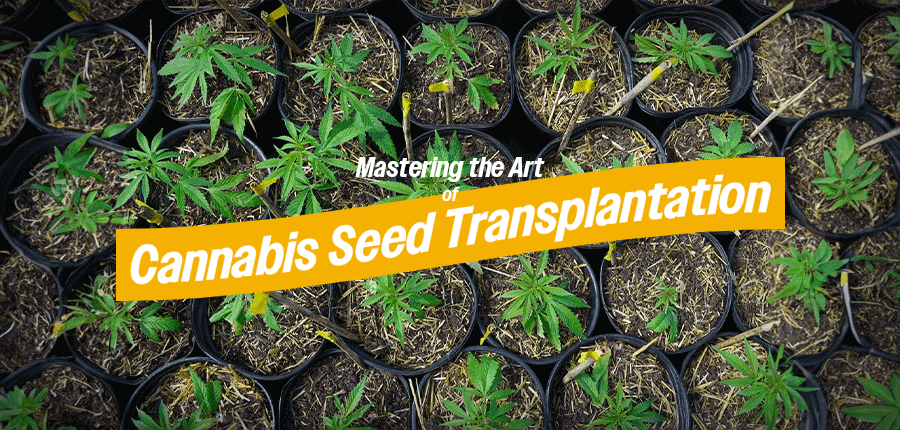

Over the years, the field of cannabis cultivation has witnessed remarkable expansion due to the growing demand for recreational and medicinal purposes. A crucial element in this cultivation process is the transfer of cannabis seeds, involving the movement of a plant and fresh soil from one container to another. Understanding the importance and advantages of transplanting cannabis seedlings is paramount, as it plays a fundamental role in promoting the vigorous and healthy growth of cannabis plants.
The transplantation of cannabis seedlings is crucial to ensure the optimal growth and development of the plant. These young plants necessitate specific environments that support root growth, and timely transplantation guarantees sufficient space and nutrients for thriving. By transplanting cannabis, the negative impacts of overcrowding and resource competition on plant growth are significantly reduced. Additionally, moving the seedlings into larger pots enables their roots to spread out, facilitating improved water absorption and nutrients from the soil. As a result, the overall health and vitality of the plant are strengthened.
| Key Points | Description |
| Optimal selection of containers | When transplanting cannabis seedlings, it is important to choose containers that are suitable in size and made from appropriate materials. This ensures sufficient space for seedling growth and allows for proper drainage, preventing issues like waterlogging. The container material should also allow for breathability, promoting adequate airflow to the roots and preventing root rot. |
| Preparation of soil or growing medium | Another crucial aspect of cannabis transplantation is preparing the soil or growing medium. The selected soil or medium should be nutrient-rich and have good drainage properties to prevent waterlogging, which can lead to root rot. Maintaining the soil’s pH level between 6.0 and 7.0 is crucial for optimal nutrient absorption. Adding compost, perlite, or vermiculite to the soil can increase nutrient content and improve drainage, ultimately enhancing plant growth. |
| Timely transplantation | Ensuring the proper timing for transplanting cannabis seedlings is critical for their growth and development. It is advisable to transplant the seedlings when they have developed strong roots and have two to three sets of leaves. Transplanting them too early or too late can result in stunted growth, as the seedlings may require further root development to absorb water and nutrients effectively. |
| Pre-transplantation watering and feeding | Before transplanting cannabis, it is important to provide adequate water and nutrients to nurture the delicate seedlings. Maintaining the right moisture levels is crucial for developing robust roots, while excessive watering should be avoided to prevent waterlogging and root rot. Regulating watering practices is important to maintain optimal soil moisture. Additionally, providing seedlings with a balanced fertilizer can enhance their healthy growth and development. Following proper watering and feeding practices is essential to support the overall health of the plants. |
Before proceeding, ensure the soil or growing medium is well-drained and nutrient-rich.
Fill the container with the prepared soil, leaving enough space for the seedling’s root ball.
Create a hole in the center of the soil, ensuring it is large enough to accommodate the seedling’s root ball.
Gently remove the seedling from its previous container, not damaging the delicate roots.
Place the seedling into the hole you created, ensuring the root ball is adequately covered with soil.
Water the seedling cautiously, avoiding overwatering. The soil should be moist but not excessively saturated.
Find a suitable area with ample light and position the container there. Provide necessary nutrients as required to support healthy growth.
Keep a close eye on the seedling during the initial days to ensure a smooth adaptation to its new environment. Adjust watering or nutrient levels if any signs of stress, such as wilting, are observed.
To minimize the impact of transplant shock, it is important to create a stable and stress-free environment for the seedlings. This involves relocating them to a shaded area, reducing water and nutrient intake, and avoiding physical disturbances.
To prevent waterlogging and root rot, it is crucial to avoid overwatering. Reduce the watering frequency and allow the soil to dry out between each watering slightly. Ensuring good drainage and maintaining a well-ventilated environment is also essential.
To address underwatering, increase the watering frequency and ensure that the soil maintains adequate moisture levels. Incorporating mulch or moisture-retaining substances into the soil can assist in retaining moisture and preventing rapid evaporation.
In the case of nutrient deficiencies, supplement the seedlings with essential nutrients. This can be achieved by using fertilizers or organic amendments. Additionally, adjusting the soil’s pH level within the optimal range of 6.0-7.0 improves nutrient uptake and utilization.
Identifying and addressing any problems is crucial to promote the seedlings’ healthy development. Regularly monitor their growth and adapt to environmental factors in order to prevent and mitigate common issues following transplantation.
In the ever-evolving landscape of cannabis exploration, Jack Herer has ...
Within the cannabis realm, specific varieties have attained iconic status, ...
Bhang, deeply ingrained in Indian customs, stands as a time-honored ...
Shopping with us is 100% secure! We don’t keep personal details.
Important Links
Subscribe and Get 10% Off
Connect With Us